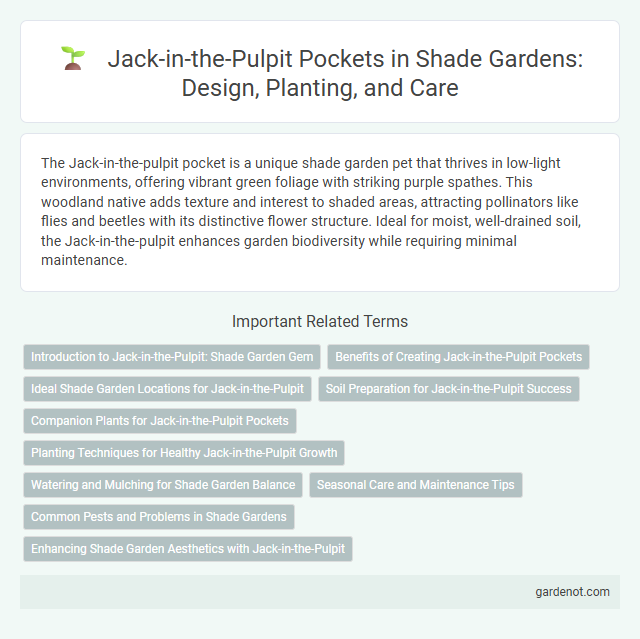The Jack-in-the-pulpit pocket is a unique shade garden pet that thrives in low-light environments, offering vibrant green foliage with striking purple spathes. This woodland native adds texture and interest to shaded areas, attracting pollinators like flies and beetles with its distinctive flower structure. Ideal for moist, well-drained soil, the Jack-in-the-pulpit enhances garden biodiversity while requiring minimal maintenance.
Introduction to Jack-in-the-Pulpit: Shade Garden Gem
Jack-in-the-pulpit (Arisaema triphyllum) thrives in shaded woodland settings, making it a perfect native gem for shade gardens. This unique perennial features a distinctive hooded flower spathe that resembles a preacher's pulpit, attracting pollinators like fungus gnats. Its adaptability to moist, well-drained soils and dappled light ensures low maintenance while adding intriguing texture and color to shaded garden landscapes.
Benefits of Creating Jack-in-the-Pulpit Pockets
Creating Jack-in-the-pulpit pockets enhances shade gardens by introducing unique structural interest and seasonal color variation. These pockets provide natural habitats for beneficial insects and pollinators while improving soil health through organic matter accumulation. The distinctive appearance of Jack-in-the-pulpit plants also adds ecological value and supports biodiversity in low-light garden areas.
Ideal Shade Garden Locations for Jack-in-the-Pulpit
Jack-in-the-pulpit thrives in moist, shaded woodland areas with rich, well-draining soil, making forest understories and north-facing slopes ideal for shade gardens. These locations offer consistent moisture and protection from harsh sunlight, which helps maintain the plant's vibrant foliage and distinctive flower structure. Incorporating organic mulch enhances soil fertility and moisture retention, creating an optimal microenvironment for Jack-in-the-pulpit growth.
Soil Preparation for Jack-in-the-Pulpit Success
Jack-in-the-pulpit thrives in moist, well-drained, acidic to neutral soil enriched with organic matter, mimicking its native woodland environment. Amending garden soil with rich compost and leaf mulch enhances moisture retention and nutrient availability, crucial for robust growth. Proper soil preparation ensures a balanced pH of 5.5 to 7.0 and consistent moisture, preventing root rot and supporting healthy foliage development.
Companion Plants for Jack-in-the-Pulpit Pockets
Jack-in-the-pulpit (Arisaema triphyllum) thrives when paired with companion plants like ferns, hostas, and Solomon's seal, which share similar shade and moisture requirements. These plants create a layered understory effect that enhances soil moisture retention and supports ecological balance. Interplanting with wild ginger or bloodroot can also provide ground cover and help suppress weeds around Jack-in-the-pulpit pockets.
Planting Techniques for Healthy Jack-in-the-Pulpit Growth
Jack-in-the-pulpit thrives in consistently moist, well-draining soil rich in organic matter, making a shaded garden bed with leaf mulch ideal for planting. Plant tubers 3-4 inches deep in early spring or fall to support robust root development and prevent rot. Regular watering combined with dappled sunlight helps maintain moisture without causing waterlogging, ensuring healthy growth and vibrant foliage.
Watering and Mulching for Shade Garden Balance
Jack-in-the-pulpit thrives in consistently moist, well-drained soil, requiring regular watering to maintain hydration without waterlogging. Applying a 2-3 inch layer of organic mulch such as shredded leaves or bark preserves soil moisture, suppresses weeds, and stabilizes soil temperature in shade garden environments. Proper watering and mulching practices support the plant's natural growth cycle and enhance overall shade garden balance.
Seasonal Care and Maintenance Tips
Jack-in-the-pulpit thrives in shaded, moist environments and requires consistent watering during dry spells in spring and early summer. Remove yellowing leaves in late fall to prevent fungal diseases and promote healthy growth the following season. Applying a layer of organic mulch helps retain soil moisture and regulates temperature around the root zone.
Common Pests and Problems in Shade Gardens
Jack-in-the-pulpit (Arisaema triphyllum) often faces challenges from slugs and snails, which can damage its delicate foliage in shade gardens. Fungal diseases such as leaf spot and root rot may also affect plants grown in poorly drained soils. Proper garden hygiene and ensuring good air circulation help minimize these common pests and problems.
Enhancing Shade Garden Aesthetics with Jack-in-the-Pulpit
Jack-in-the-pulpit (Arisaema triphyllum) adds distinctive architectural interest to shade gardens with its unique hooded spathe and variegated leaves. This native woodland plant thrives in moist, well-drained soils under dense canopy cover, making it ideal for enhancing shaded garden areas. Its early spring blooms and seasonal berry clusters provide dynamic visual appeal and support local pollinators, enriching the biodiversity of shaded garden ecosystems.
Jack-in-the-pulpit pocket Infographic

 gardenot.com
gardenot.com